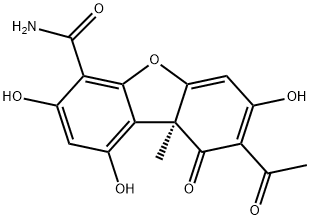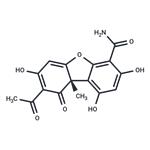Cercosporamide was originally identified as a host-selective phytotoxin and broad spectrum antifungal agent isolated from Cercosporidium henningsii. More recently, cercosporamide was shown to inhibit a cell wall integrity pathway mediated through a serine/threonine protein kinase, Pkc1, that is central to cell wall biosynthesis. It is both a potent (IC50<50nM) and selective inhibitor of Pkc1 kinase.
Cercosporamide is a potent inhibitor of MAP-kinase interacting kinase-2 (Mnk2) and JAK3. Cercosporamide effectively inhibits eIF4E phosphorylation as well as inibitiing inhibits Pkc1. Cercosporamide displays antiproliferative and proapoptotic activity in cancer cells in vitro.
Cercosporamide is a natural antifungal phytotoxin isolated from the Cercosporidium fungus, which infects the leaves of cassava plants. Its antifungal effect results from its selective and potent inhibition of fungal PKC-like 1 kinases (Pkc1), which are central to cell wall integrity (IC50 = 25 nM for Candida Pkc1). Cercosporamide less effectively inhibits human PKC isoforms PKCα, β, and γ (IC50s = 1.02, 0.35, and 5.8 μM, respectively), an action linked to lowering of plasma glucose in hyperglycemic mice. However, it potently inhibits MAPK-interacting kinases Mnk1 and Mnk2 (IC50 = 115 and 11 nM, respectively), reducing protein translation in cancer cells. Cercosporamide is orally bioavailable.
ChEBI: A member of the class of dibenzofurans that is a potent broad spectrum antifungal agent isolated from the fungus Cercosporidium henningsii.
Cercosporamide was initially identified as a phytotoxin with broad-spectrum anti-fungal activity. Studies have shown that cercosporamide is a specific, highly potent fungal inhibitor of the cell wall integrity-signaling pathway mediator, protein kinase (Pkc1) inhibitor. Semisynthetic cercosporamide analogues demonstrated hypoglycemic activity and therefore, serve as candidates for potential new anti diabetic drugs. Cercosporamide was found to block eIF4E (Eukaryotic Initiation Factor) phosphorylation in cultured cancer cells, inducing apoptosis, suppressing proliferation, and reducing soft agar colonization. Its eIF4E phosphorylation inhibitory effect was also shown when administrated orally on xenograft human tissue and mouse liver tissue. Cercosporamide is a potent and selective Mnk inhibitor. It reduces tumor growth in xenografted HCT116 tumor and suppresses the outgrowth of B16 melanoma lung metastases. Hence, blocking Mnk function and eIF4E phosphorylation may be an attractive anticancer strategy.
Treatment with Cercosporamide or Ara-C alone significantly suppresses xenograft growth when compared with the respective vehicle (P<0.011 for 10 mg/kg twice-daily Cercosporamide; P<0.006 for Cercosporamide 20 mg/kg daily; P<0.0374 for Ara-C). The combination of Cercosporamide 10 mg/kg twice daily plus Ara-C is significantly more effective than either agent alone (P<0.0009 vs Cercosporamide; P=0.005 vs Ara-C; P<0.0001 vs either vehicle). Cercosporamide (20 mg/kg once daily) in combination with Ara-C shows similar effects, with significant inhibition of tumor growth vs captisol (P<0.0001) or water (P=0.0003), but does not show statistical significance vs Cercosporamide alone (20 mg/kg) or Ara-C alone[2].
Pkc1: 50 nM (IC50); Pkc1: 7 nM (Ki); Mnk


